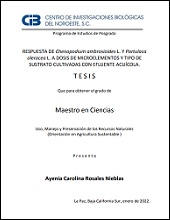Mostrar el registro sencillo del ítem
RESPUESTA DE Chenopodium ambrosioides L. Y Portulaca oleracea L. A DOSIS DE MICROELEMENTOS Y TIPO DE SUSTRATO CULTIVADAS CON EFLUENTE ACUÍCOLA
| dc.contributor.advisor | Murillo Amador, Bernardo | |
| dc.contributor.author | Rosales Nieblas, Ayenia Carolina | |
| dc.date.issued | 2022 | |
| dc.identifier | https://cibnor.repositorioinstitucional.mx/jspui/handle/1001/2618 | |
| dc.identifier.uri | http://dspace.cibnor.mx:8080/handle/123456789/3108 | |
| dc.description.abstract | "El contenido deficiente de microelementos (µE) en los efluentes acuícolas es una de las principales limitantes para su uso como solución nutritiva (SN) en sistemas hidropónicos, debido a que estos son requeridos por las plantas para lograr su potencial productivo máximo. En el manejo agronómico, la selección del sustrato es importante debido a que el rendimiento varía en función de las características fisicoquímicas de estos. El consumo de plantas ancestrales y cosmopolitas, como Chenopodium ambrosioides L. y Portulaca oleracea L. ha incrementado debido a sus propiedades culinarias y medicinales que permiten su comercialización internacional, por lo que se espera que su inclusión en los sistemas hidropónicos cultivados con efluentes acuícolas represente alternativas viables para los productores. En este estudio se determinó la respuesta fisiológica y morfométrica de dichas especies, así como el consumo y la calidad del efluente a dosis de µE (0, 20 y 100 %) de la SN de Hoagland y Arnon y dos tipos de sustratos (esponja y sustrato comercial + vermiculita) utilizando efluente acuícola de Orechromis niloticus durante un ciclo de 30 días en el sistema hidropónico. Los tratamientos se conformaron de la manera siguiente: 0ES, 0EE, 20ES, 20EE, 100ES, 100EE y 0VS, 0VE, 20VS, 20VE, 100 VS, 100VE (dosis de µE; E (C. ambrosioides) o V (P. oleracea); S (sustrato comercial + vermiculita) o E (esponja)). A los 30 días después de la adición de microelementos (DDAM) las variables morfométricas de plantas de C. ambrosioides mostraron los valores más altos (Tukey HSD, p≤0.05) en las variables biomasa fresca y seca, área foliar y longitud del tallo cuando se cultivaron en el tratamiento 100EE, mientras que en P. oleracea los valores mayores se presentaron en las plantas cultivadas con el tratamiento 100VS, destacando principalmente una diferencia en el crecimiento debido al sustrato utilizado. Las variables fisiológicas de plantas de C. ambrosioides mostraron los valores mayores (Tukey HSD, p≤0.05) de clorofila a y b cuando se cultivaron con los tratamientos 20EE y 100EE, mientras que las plantas de P. oleracea mostraron el potencial hídrico menor en las plantas cultivadas en el tratamiento 20VE..." | es |
| dc.format | es | |
| dc.language.iso | spa | es |
| dc.publisher | Centro de Investigaciones Biológicas del Noroeste, S.C. | es |
| dc.rights | Acceso abierto | es |
| dc.subject | acuaponía, deficiencia nutricional, microelementos, tolerancia | es |
| dc.subject | aquaponics, nutritional deficiency, microelements, tolerance | es |
| dc.subject.classification | NUTRICIÓN VEGETAL | es |
| dc.title | RESPUESTA DE Chenopodium ambrosioides L. Y Portulaca oleracea L. A DOSIS DE MICROELEMENTOS Y TIPO DE SUSTRATO CULTIVADAS CON EFLUENTE ACUÍCOLA | es |
| dc.type | masterThesis | es |
| dc.dirtesis.grado | Maestría en Ciencias en el Uso, Manejo y Preservación de los Recursos Naturales | es |
| dc.dirtesis.disciplina | Agricultura Sustentable | es |
| dc.dirtesis.universidad | Centro de Investigaciones Biológicas del Noroeste, S.C. | es |
| dc.dirtesis.facultad | Posgrado en Recursos Naturales | es |
| dc.description.abstracten | "The deficient content of microelements (µE) in aquaculture effluents is one of the main limitations for its use as a nutrient solution (NS) in hydroponic systems since these are required by plants to achieve their maximum productive potential. In the agronomic management, the selection of the substrate is important because the yield varies depending on the physicochemical characteristics of substrates. The consumption of ancestral and cosmopolitan plants, such as Chenopodium ambrosioides L. and Portulaca oleracea L. has increased due to their culinary and medicinal properties that allow their international commercialization, so their inclusion in hydroponic systems grown with aquaculture effluents is expected to represent viable alternatives for producers. In this study, the physiological and morphometric response of these species was determined, as well as the consumption and quality of the effluent at doses of µE (0, 20 and 100 %) of the NS of Hoagland and Arnon and two types of substrates (sponge and commercial substrate + vermiculite) using Orechromis niloticus aquaculture effluent during a 30-day cycle in the hydroponic system. The treatments were made up as follows: 0ES, 0EE, 20ES, 20EE, 100ES, 100EE and 0VS, 0VE, 20VS, 20VE, 100 VS, 100VE (dose of µE; E (C. ambrosioides) or V (P. oleracea); S (commercial substrate + vermiculite) or E (sponge)). At 30 days after the addition of microelements (DDAM) the morphometric variables of C. ambrosioides plants showed the highest values (Tukey HSD, p≤0.05) in the variables fresh and dry biomass, leaf area and stem length when were cultivated in the 100EE treatment, while in P. oleracea the highest values were presented in the plants cultivated with the 100VS treatment, mainly highlighting a difference in growth due to the substrate used. The physiological variables of C. ambrosioides plants showed the highest values (Tukey HSD, p≤0.05) of chlorophyll a and b when they were grown with the 20EE and 100EE treatments, while the plants of P. oleracea showed the lowest water potential in the plants grown in treatment 20VE..." | es |

